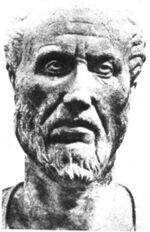Religion:De Coelesti Hierarchia
From HandWiki
Short description: Pseudo-Dionysian work on angelology, 5th ct.
| Part of a series on |
| Neoplatonism |
|---|
 |
De Coelesti Hierarchia (Greek: Περὶ τῆς Οὐρανίας Ἱεραρχίας, translit. Peri tēs Ouranias Hierarchias, "On the Celestial Hierarchy") is a Pseudo-Dionysian work on angelology, written in Greek and dated to ca. AD the 5th century; it exerted great influence on scholasticism and treats at great length the hierarchies of angels.
Candida Moss states that the described heavenly hierarchy of angels under God modeled the imperial court structure of the Roman Empire.[1]
In Catholicism
Thomas Aquinas (Summa Theologica, I.108) follows the Hierarchia (6.7) in dividing the angels into three hierarchies each of which contains three orders, based on their proximity to God, corresponding to the nine orders of angels recognized by Pope Gregory I.
- Seraphim, Cherubim, and Thrones;
- Dominations, Virtues, and Powers;
- Principalities, Archangels, and Angels.
Editions
- Pseudo-Dionysius Areopagita, De Coelesti Hierarchia, Surrey, 1935. Shrine of Wisdom ISBN:978-0-90066-403-8.
- G. Heil, A. M. Ritter, Pseudo-Dionysius Areopagita. De Coelesti Hierarchia, De Ecclesiastica Hierarchia, De Mystica Theologia, Epistulae (1991) ISBN:978-3-11-012041-7.
See also
- Orthodox St. Dionysus Institute in Paris
- Christian angelic hierarchy
- Gregory Palamas
- Apophatic theology
- Hesychasm
- Seven archangels
- Vladimir Lossky
References
- ↑ Moss, Candida R (24 May 2010). The Other Christs: Imitating Jesus in Ancient Christian Ideologies of Martyrdom. New York: Oxford University Press. p. 256. ISBN 9780199772933. https://books.google.com/books?id=EfsHl74FzMIC. Retrieved 25 March 2023. "[...] the fourth-century Hierarchia coelestis of Pseudo-Dionysius, where the relationship of angels to God was modeled on that of the imperial court."
External links
- The Celestial Hierarchy – full text translated into English (1899)
- The Celestial Hierarchy (original Ancient Greek text)
 |


